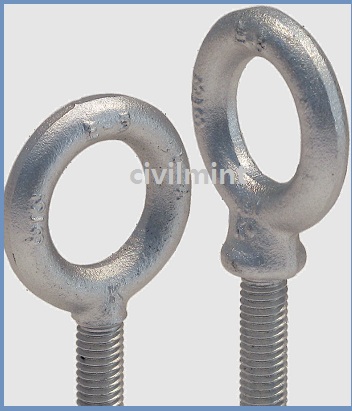Table of Contents
Introduction
Eyebolts are mechanical fasteners with a threaded shank and a ring end. The primary object of an eyebolt is to attach an eye to a structure, through which wires, cables, or shackles can be attached. A common use is to create a lifting eye to be able to attach the crane to a machine, with a special purpose that the eye is rated for a safe working load.

Low tension eye bolts are normally formed from a length of a rod having a diameter of the nominal thread size. The tip is simply bent into a loop from an unread part of the rod. These eye bolts can reasonably support axial loads but should not be used for off-axis loads. The opening where the end of the rod is closed to complete the ring can be welded but is still likely to be a breakpoint.
High-strength eye bolts with forged heads typically include a substantial shoulder. Shoulders allow them to support large loads off-axis. Off-axis load carrying capacity is often important in lifting applications where multi-leg lift cables are used to attach multiple lifting eyes.
When lifting machinery, it is common to screw the bolt directly into a threaded hole in the structure. In this case, there should be an eye circle that is fully connected to the shoulder. When an Eyebolts are designed to fit into a hole and is secured with a nut on the other side, it is preferable to have a shank. The shaft is a non-overturning part of the shaft, below the shoulder, allowing better load transfer to the hole surface and less chance of cracking under fatigue loads.
Types of Eyebolts
The most popular types of eyebolts are as follows.
- Anchor eyebolts
- Screw eyes
- Ring bolt
- Eye nut
- Pigtail eye bolts
- Roller eyebolt
Let’s have a look at the above-mentioned eyebolts.
- Anchor eyebolts: Eyebolts with a type of anchor bolt that can be attached to masonry structures.
- Screw Eyes: Similar to eyebolts, but with wood screws instead of machine screws. These are used to attach eyelets to wooden or plastic structures. Small screw eyelets are used to hang picture frames and curtain wires.
- Ring Bolt: A ring bolt with a captive ring that goes through the eyes of the head, effectively forming the two links in the chain. This can reduce the bending force to the eyebolt.
- Eye nuts: Eye nuts are actually nuts that serve the same purpose as eye bolts, but are sometimes referred to in the catalog as eye bolts.
- Pigtail eye bolts: Like regular low-strength eyebolts, they are formed from the length of the rod, but the head is bent in a spiral so it cannot be closed completely, but it can exceed 360 degrees. This allows you to screw the center of the rope into the eyelet without having to access both ends.
- Pulley Eyelet: Used to guide ropes or cables, allowing smooth passage with minimal friction. The head is actually an assembly with four rollers retaining the rope which passes through it.
The Parts of an Eye Bolt
- Eye: Loops formed on top for bending, welding, and forging
- Shoulder: A “skirt” where eyelets and shanks meet to prevent bending
- Shank: Thread shank that sticks to the eyes
For better understanding, I have shown these parts in the figure given below.

